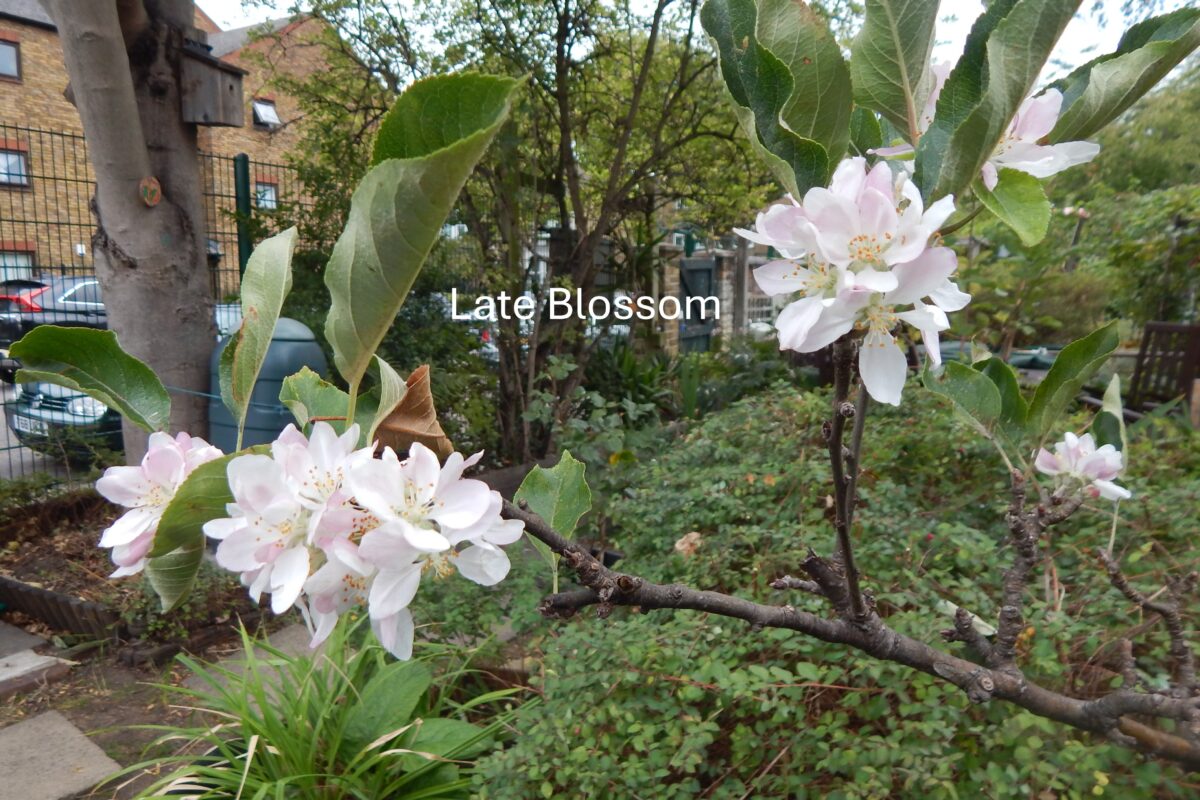The apple tree, given to us by the Irish pensioners, is in bloom. Quite shockingly so, as April is the month for apple blossom. This is five months on. Though, September is very like April in terms of temperatures and day-length. It seems the tree has picked up on these signals, perhaps enhanced by the dryness back in April. It would be interesting if apples began to develop. What would happen to them as the year cooled and we slipped into winter months? Not likely as most apply trees need a pollinator, another apply tree, nearby to create the pollen to fertilise these blooms. One freak blooming is unlikely to be repeated by another close by.
This is the time for Michaelmas daisies, not apple blossom, and we have some near the gate and at the back of the shelter. A little way off in the small square bed there’s a few sunflower. That bed does get snails in wet weather and they do like sunflowers. But it was dry as the plants were maturing, which kept the snails dormant and allowed the sunflowers to thrive.
In the wildflower bed, which is looking pretty ragged, a corn marigold has come through. They are more yellow than regular marigolds, and the flowers are single rather than the clusters of marigolds. Around the garden, there are quite a few marigolds, dead-heading keeps them flowering. We have a couple of tubs of colourful petunias, blue and white and red, along the pergola. The Forthergill bed has evening primroses, bright yellow flowers which open in the evening to attract pollinators such as moths, hence the flower name.
I was asked by a volunteer why her cherry tree was so prolific this year, while she had barely any last year. The answer is most likely weather related. High winds can destroy cherry blossom. I have noted this with our ornamental cherry tree. It’s blossom doesn’t last long at the best of times, but strong winds batter the blossoms and create a carpet of pink petals, as if there has been a wedding, making its flowering days even shorter.
Our olive tree had five fruits last year; I’d hoped for more this year, but we had none at all. Squirrels got the walnuts, and birds, or maybe squirrels, had most of our grapes. I saw a squirrel today at our bird feeder; most acrobatic as it nibbled at the nuts.
The agapanthus is in seed. It has a large spherical clusters of violet-blue florets in summer. The seed-heads are like miniature paddles, each a legacy of a floret. There are helicopters from the sycamore windblown around the garden, but less noticeable are the tiny seeds of the silver birch. Untended the garden would become a jungle of sycamores, silver birch and buddleia, each competing for space.
Two doors from our door fence have been replaced. Five years ago, the original fence was near collapse, and Sophie, our much loved former administrator, had the idea to have a door fence. The call went out and in the end we got about 30 doors. Some internal, some external. I am sure many of the contributors were pleased to pass them on, otherwise what do you do with old doors? The door fence was erected and we left on the door handles and other embellishments, so it looked as if they were doors to some mysterious place. The two doors being replaced were both internal doors; five years of wind and rain has been too much for them. They were never built for the weather, but for nice warm hallways, made from a thin outer layers of wood filled often with cardboard, whereas external doors are solid wood, built to last.
Monday, 22 September is the Autumnal Equinox. The day when night and day are equal. After Monday, the nights win out until we get to the Winter Solstice at the end of December. The equinox varies in date by a few dates, this is because the Earth’s orbital period is not exactly 365 days but is closer to 365.25 days. This extra quarter of a day causes the equinox to shift about six hours later each year. This is why the date can vary from 21 to 24 September. The extra day added each leap year resets the equinox, so keep it between these dates. Without it, the equinox day would drift later by a quarter of a day each year, and so in a century the date would be well into October.

